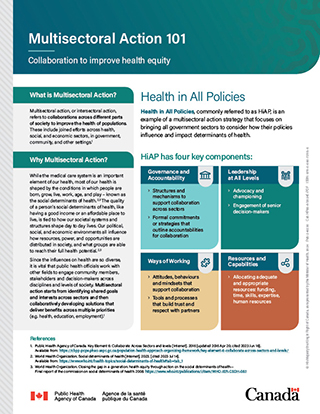Multisectoral action 101
Download in PDF format
231 KB, 1 pages)
Organization: Public Health Agency of Canada
Date published: May 2024
ISBN: 978-0-660-72115-6
Pub: 240230
What is multisectoral action?
Multisectoral action, or intersectoral action, refers to collaborations across different parts of society to improve the health of populations. These include joined efforts across health, social, and economic sectors, in government, community, and other settings.Footnote 1
Why multisectoral action?
While the medical care system is an important element of our health, most of our health is shaped by the conditions in which people are born, grow, live, work, age, and play – known as the social determinants of health.Footnote 2Footnote 3 The quality of a person’s social determinants of health, like having a good income or an affordable place to live, is tied to how our societal systems and structures shape day to day lives. Our political, social, and economic environments all influence how resources, power, and opportunities are distributed in society, and what groups are able to reach their full health potential.Footnote 2Footnote 3
Since the influences on health are so diverse, it is vital that public health officials work with other fields to engage community members, stakeholders and decision-makers across disciplines and levels of society. Multisectoral action starts from identifying shared goals and interests across sectors and then collaboratively developing solutions that deliver benefits across multiple priorities (e.g. health, education, employment).Footnote 1
Health in All Policies, commonly referred to as HiAP, is an example of a multisectoral action strategy that focuses on bringing all government sectors to consider how their policies influence and impact determinants of health. HiAP has four key components:
- Governance and accountability
- Structures and mechanisms to support collaboration across sectors
- Formal commitments or strategies that outline accountabilities for collaboration
- Leadership at all levels
- Advocacy and championing
- Engagement of senior decision-makers
- Ways of working
- Attitudes, behaviours and mindsets that support collaboration
- Tools and processes that build trust and respect with partners
- Resources and capabilities
- Allocating adequate and appropriate resources: funding, time, skills, expertise, human resources
Public health officials need to build their skills for and advance each of these components for successful collaborations with other sectors.
References
- Footnote 1
-
Public Health Agency of Canada. Key Element 6: Collaborate Across Sectors and levels [Internet]. 2016 [updated 2016 Apr 20; cited 2023 Jun 16]. Available from: https://cbpp-pcpe.phac-aspc.gc.ca/population-health-approach-organizing-framework/key-element-6-collaborate-across-sectors-and-levels/
- Footnote 2
-
World Health Organization. Social determinants of health [Internet]. 2023. [cited 2023 Jul 14]. Available from: https://www.who.int/health-topics/social-determinants-of-health#tab=tab_1
- Footnote 3
-
World Health Organization. Closing the gap in a generation: health equity through action on the social determinants of health - Final report of the commission on social determinants of health. 2008. https://www.who.int/publications/i/item/WHO-IER-CSDH-08.1
Page details
- Date modified:
